Click on images to enlarge
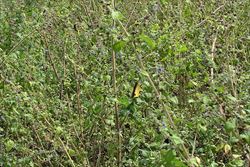
dense infestation (Photo: Chris Gardiner)

habit prior to flowering (Photo: Chris Gardiner)

habit in fruit (Photo: Sheldon Navie)
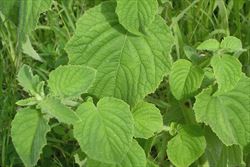
lower leaves (Photo: Chris Gardiner)
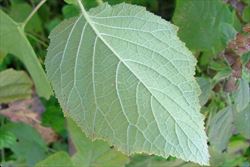
close-up of leaf underside (Photo: Sheldon Navie)
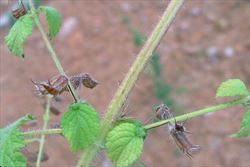
close-up of upper leaves and hairy four-sided stems (Photo: Sheldon Navie)
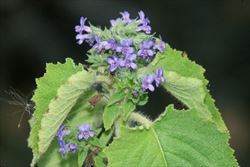
young flower clusters (Photo: Chris Gardiner)

branched stems with older flower clusters and immature fruit (Photo: Chris Gardiner)

upper leaves and flowers (Photo: Chris Gardiner)

close-up of flowers (Photo: Sheldon Navie)
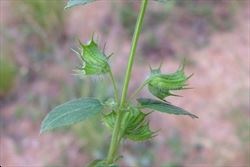
close-up of immature fruit (Photo: Sheldon Navie)

clusters of mature fruit with seeds (Photo: Sheldon Navie)
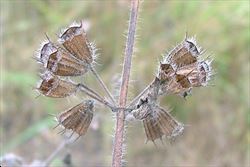
close-up of mature fruit (Photo: Sheldon Navie)

close-up of seeds (Photo: Steve Hurst at USDA PLANTS Database)
Scientific Name
Mesosphaerum suaveolens (L.) Kuntze
Synonyms
Hyptis suaveolens (L.) Poit.; Ballota
suaveolens L.
Family
Labiatae (South Australia)Lamiaceae (Queensland, New South Wales, the ACT, Victoria, Tasmania, Western Australia and the Northern Territory)
Common Names
chan, Chinese mint, horehound, hyptis, mint weed, mintweed, pignut, wild spikenard
Origin
This species originated in Central America and tropical South America.
Naturalised Distribution
Widely naturalised in northern Australia (i.e. in northern and eastern Queensland, in the northern and central parts of the Northern Territory, and in northern Western Australia).
Also naturalised in Papua New Guinea and on several Pacific islands (e.g. Guam, Niue and Hawaii).
Habitat
Most common in wetter tropical regions, but sometimes also growing in sub-tropical and semi-arid environments. A weed of roadsides, crops and cultivation, pastures, rangelands, grasslands, open woodlands, riverbanks, floodplains, coastal environs, disturbed sites and waste areas.
Habit
An upright (i.e. erect), short-lived (i.e. annual) or long-lived (i.e. perennial), herbaceous plant usually growing 1-1.5 m tall, but occasionally reaching up to 3 m in height.
Distinguishing Features
- an upright and branched herbaceous plant usually growing 1-1.5 m tall.
- its stems are hairy and square in cross-section, while its oppositely arranged leaves have shallowly toothed margins.
- the leaves of this species give off a strong minty smell when crushed.
- its pinkish, bluish-purple or lavender tubular flowers (5-7 mm long) are arranged in 1-5 flowered clusters in the upper leaf forks.
- these small flowers are surrounded by a green tubular structure that turns brown and persists after the flower dies.
- this tubular structure has five lobes, each lobe being topped with a short bristle (about 5 mm long).
Stems and Leaves
The branching stems are green or reddish-green in colour and square in cross-section (i.e. quadrangular) when young. On the upper parts of the plant the stems are about 5 mm thick and somewhat hairy (i.e. pubescent). However, they are often thicker and become slightly woody towards the base of the plant.
The oppositely arranged leaves (2-10 cm long and 1-7 cm wide) are borne on stalks (i.e. petioles) 5-40 mm long. They are egg-shaped in outline (i.e. ovate), oval (i.e. elliptic), or slightly heart-shaped (i.e. cordate). Their margins are shallowly toothed (i.e. crenate or serrate) and they are quite hairy (i.e. pubescent).
Flowers and Fruit
The small pinkish, bluish-purple or lavender coloured flowers (5-7 mm long) are arranged in 1-5 flowered clusters in the upper leaf forks (i.e. axils). They are borne on short stalks (i.e. pedicels) 1-5 mm long and are tubular in appearance with two 'lips' (i.e. they are two-lipped or bi-labiate). The upper lip is divided into two lobes and the lower lip divided into three lobes, with the central lobe having an inflated appearance (i.e. it is saccate). These flowers are surrounded by a green tubular structure that is formed from the five fused sepals (i.e. a calyx tube). It has five lobes, each being topped with a short bristle (about 5 mm long), and turns brown in colour after the flower dies. Flowering occurs mainly from late summer through until late winter.
The fruit is a lobed structure (i.e. schizocarp) that divides into two 'seeds' (i.e. nutlets or mericarps). These 'seeds' (3-4 mm long and 2.5-3 mm in wide) are dark brown to black in colour with whitish markings at one end. They are flattened, shield-shaped and slightly rough in texture.
Reproduction and Dispersal
This species reproduces by seed, which usually remain in the bristly fruit.
The fruit readily become attached to animals and clothing and are also dispersed by water, machinery, vehicles and as a contaminant of agricultural produce (i.e. fodder).
Environmental Impact
Hyptis (Mesosphaerum suaveolens) is regarded as an environmental weed in northern Queensland, the Northern Territory and northern Western Australia. It is listed as a priority environmental weed in two Natural Resource Management regions and is actively managed by community groups in the Northern Territory.
This large woody herb forms dense thickets and has the ability to shade out and displace native vegetation, especially in grazed or disturbed areas, but also in riparian vegetation and on floodplains. It is extensively naturalised in the savannas of northern Australia and was recently listed as one of the weed species posing the greatest threat to rangeland biodiversity in this part of the country.
At some locations along the Normanby and Kennedy Rivers, in northern Queensland, hyptis (Hyptis suaveolens) has been observed to dominate the ground layer with other weed species. While it does not invade the understorey of rainforest vegetation, it has been recorded as a weed of clearings and road and powerline corridors in the wet tropics region of northern Queensland. In the Northern Territory, hyptis (Hyptis suaveolens) has become widespread in the Darwin, Katherine, Gulf and Victoria River Districts and isolated infestations have been found as far south as Barrow Creek.
Other Impacts
Hyptis (Mesosphaerum suaveolens) is unpalatable to livestock has the ability to dominate improved and native pastures, especially when they are overgrazed. Hence, this species can significantly reduce the carrying capacity and/or productivity of pastures.
Legislation
This species is declared under legislation in the following states and territories:
- Northern Territory: B - growth and spread of this species to be controlled (throughout all of the Territory), and C - not to be introduced into the Territory.
- Western Australia: Prohibited - on the prohibited species list and not permitted entry into the state.
Management
For information on the management of this species see the following resources:
- the Northern Territory Department of Natural Resources, Environment and The Arts Agnote on this species, which is available online at http://www.nt.gov.au/weeds.
Similar Species
Hyptis (Mesosphaerum suaveolens) is relatively similar to knobweed (Hyptis capitata), lion's tail (Leonotis nepetifolia) and horehound (Marrubium vulgare). These species can be distinguished by the following differences:
- hyptis (Mesosphaerum suaveolens) has pinkish, bluish-purple or lavender coloured flowers that
are borne in loose few-flowered clusters in the leaf forks (i.e.
axils).
- knobweed (Hyptis capitata) has white flowers that are borne in small dense globular
clusters (15-25 mm across) at the top of stalks (i.e peduncles) 2-9 cm
long.
- lion's tail (Leonotis nepetifolia) has orange flowers that are borne in large stalkless (i.e. sessile) globular clusters (50-60 mm across) in the upper leaf forks (i.e. axils).

